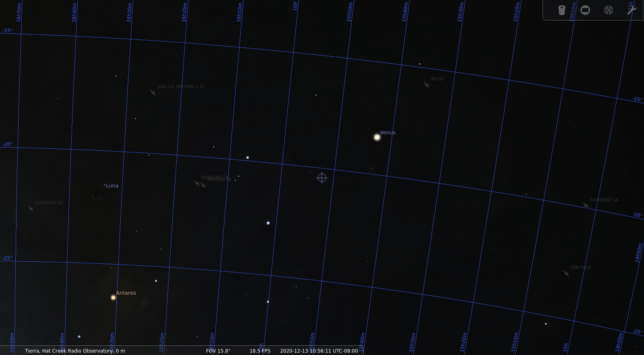Last weekend, we did two long observations of Chang’e 5 with one of the dishes from Allen Telescope Array as part of the activities of the GNU Radio community in the telescope. The recordings were done during the UTC evenings on Saturday 2020-12-12 and Sunday 2020-12-13, and almost lasted for all the time that the spacecraft was above 16.8 degrees, which is the elevation mask for the telescope. Since the Moon was at a low declination, the observations were not so long, only around 4 to 5 hours.
On Saturday, the spacecraft had already performed its TEI-1 (trans-Earth injection burn) and was on an elliptical lunar orbit. On Sunday, the spacecraft had performed TEI-2 and was already on its transfer orbit to Earth, and several degrees away from the Moon, as shown by the blue cross in the figure below, done with Stellarium.

The IQ recordings of the observations will be published in Zenodo in a few days, since I need to transfer them over the slow internet connection of the telescope. This post will be updated when they are ready.
Update 2020-12-19: The recordings are now published in the following datasets:
- Chang’e 5 RF recording at 8471.2 MHz with Allen Telescope Array between TEI-1 and TEI-2 (X polarization)
- Chang’e 5 RF recording at 8471.2 MHz with Allen Telescope Array between TEI-1 and TEI-2 (Y polarization)
- Chang’e 5 RF recording at 8471.2 MHz with Allen Telescope Array after TEI-2 (X polarization)
- Chang’e 5 RF recording at 8471.2 MHz with Allen Telescope Array after TEI-2 (Y polarization)
In this post, I look at the telemetry decoded from these recordings. Future posts will look at other aspects, such as the polarization of the signal.